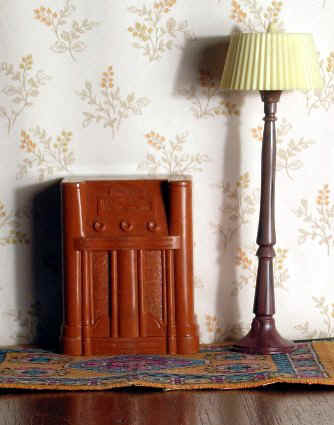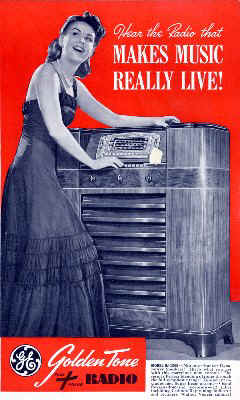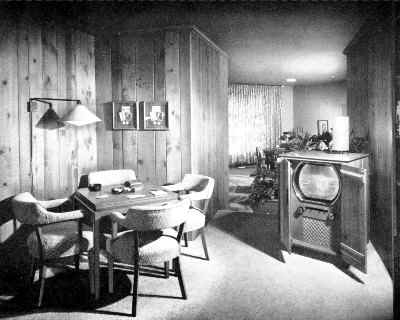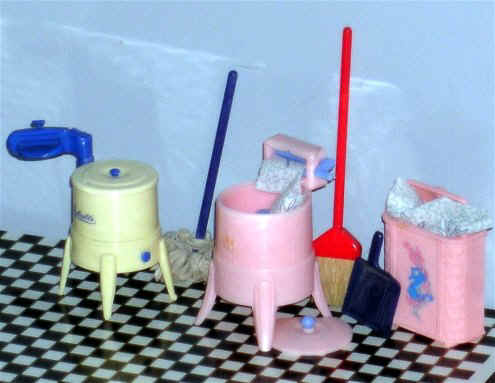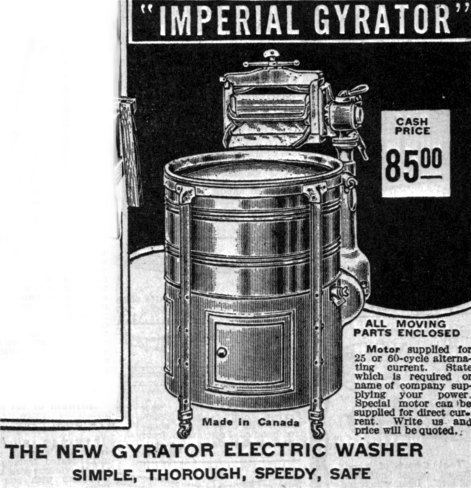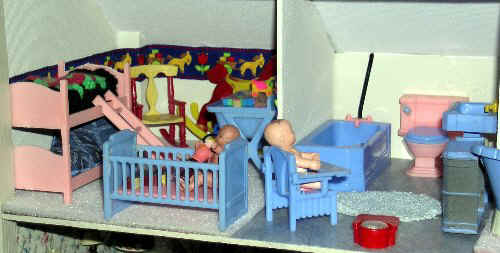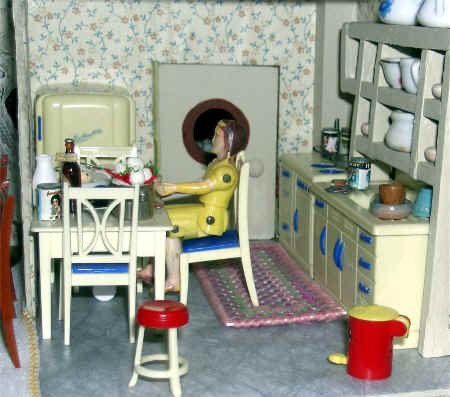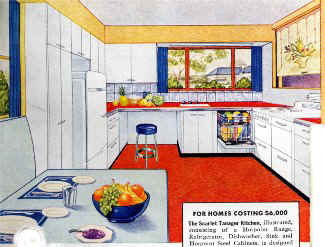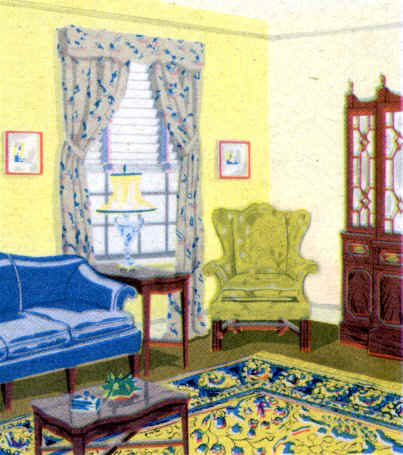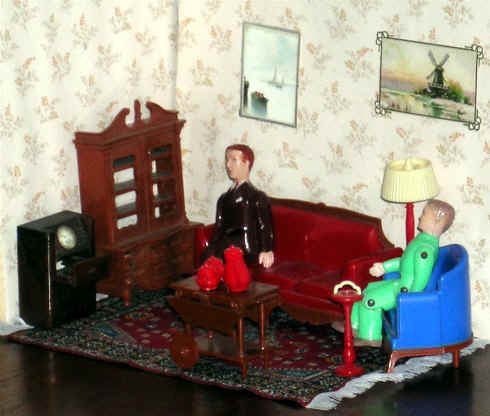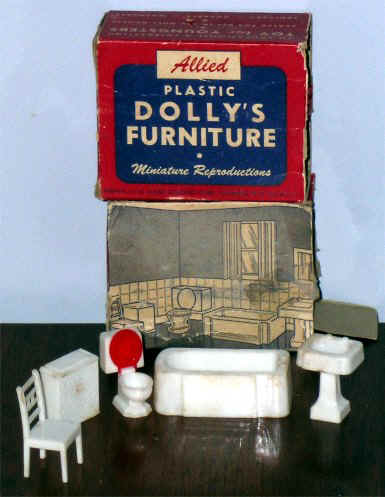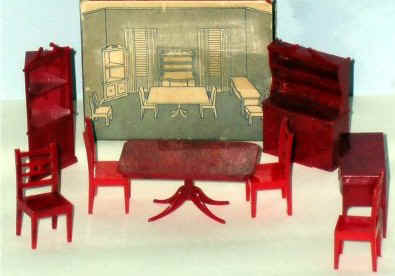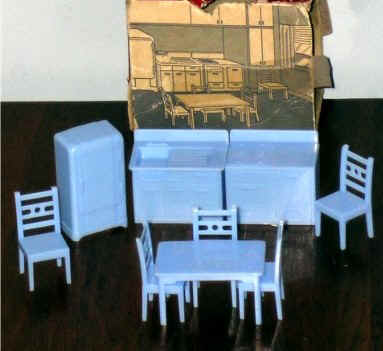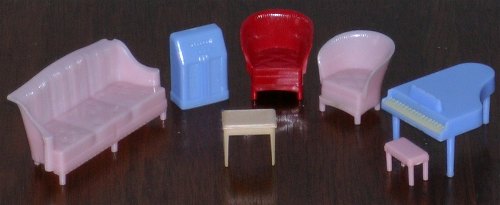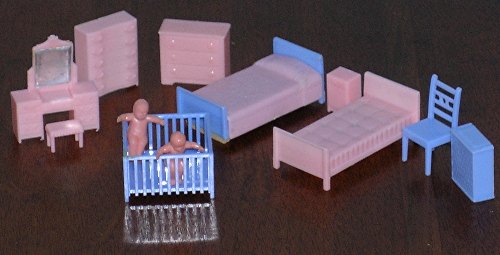1950s İ |
home page 1890s 1900-1920 part 2: 1920s part 2: late 1920s part 1: 1930s part 2: 1930s 1940s part 1: 1960-1990 part 2: 1960-1990 The decade of the 1940s was a
watershed one for dollhouses and furnishings because of the introduction of new materials
such as plastic, which was so amenable to mass production. The full benefit of these
was inherited during the decade of the 1950s, coinciding with an economic boom in North
America. The era of steel houses and plastic furniture was here to stay. The hard plastic
items could be intricately detailed including the maker's name. For such miniatures, the
struggle by collectors to identify manufacturers and countries of origin does not apply
for these products. However, the very ease with which moulded plastic could be made in
factories also spelt the end of individual variations, although factory production
throughout the first half of the 20th century had sought repetitive forms. Even so, many
1900 to 1950 miniatures had aspects of hand finishing and variations in colour. Now colour
could be controlled at the time of moulding. A glance at the products illustrated below
shows the popular colours of medium blue, strong blue, pink, red, cream, brown Steel dollhouses, first introduced about 1948, dominated the 1950s decade. Again depending upon one's point of view, the disadvantage was that the printed interior decorations and architectural components left little to the imagination. One also had to accept the rendition of three-dimensional forms on what what obviously a flat shiny surface. But one can argue that they are the descendants of a long tradition of lithographed interiors, for example, this dollhouse history began with the American McLoughlin rooms of 1894 with their very fine interior renderings 1890s . The enemy of the earlier rooms and houses was rough handling resulting in bent or marked surfaces of the cardboard or fibreboard, whereas the enemies of the metal houses were dinging and rust. Because most of the latter houses are printed with the maker's name and place, identification problems are less prevalent.
photo: J. McKendryİ
above A Marx metal house and plastic furnishings in the 1957 Montgomery Ward Toy Catalogue p.189. The Colonial style (discussed under the 1940s) had been in use for dollhouses from at least the 1920s and continued to dominate Marx dollhouses into the early 1970s. It is thus very conservative in nature in contrast to other Marx houses manufactured in split-level and ranch styles with up-to-date aspects such as breezeways and fall-out shelters. The first Colonial Marx house came out in 1949. If there was a wing, it contained either a garage or a utility room for laundry and sewing. The text below explains what the customer got for $3.79 in 1957:
To a certain degree, the six-sided, one storey steel dollhouse by the Eagle Company of Montreal, Canada, was a more advanced design than Marx's popular Colonial houses (Eagle also produced traditional Colonial or Georgian Revival houses). Illustrated below is the earlier version (a later Panorama House, boxed with bilingual text, with a different colour scheme and decor was also made). Both contained small plastic furniture but here the house is furnished with a variety of American and British plastic, wood and upholstered pieces from the 1950s and '60s in 1:16 scale. A compatible garage by Eagle is also shown. The house is very modern in appearance due to the flat, six-sided, tiled roof with skylights. Although centrally planned houses have existed for a long time, this interpretation has a definite mid 20th century stamp with its geometrical purity. This crisp quality feels more like Mies van der Rohe than the organic growth of Frank Lloyd Wright but Wright's love of the hearth as the centre of the home is seen here with a "stone" fireplace wall in the rotunda; in this instance, a British moulded fireplace has been set in place. Abstract patterns are formed in tile on the bathroom walls and are the basis of the artwork handing in the living room. If a collector is inclined to add anything to the metal walls, craft stores sell magnetic strips, which can be cut and glued to the object. The latter is held in place on the walls by the magnet and can be moved without damaging the original decoration. The foyer and each room (kitchen, bathroom, bedroom, living room, dining room) have walls that angle towards the central hall. Some rooms flow fully into the central space demonstrating the open plan of many modern houses. The circular fibreboard floor pivots on small wheels so that different rooms can face the viewer. This can be more successfully accomplished by placing the house on a turntable. One version of this house has a six-sided skylight, which was covered with a solid flat piece. The example shown here was made with either a red or green roof and may have had a clear plastic dome (or at least such a dome is shown on the box for one of the Panorama versions -- another had with a solid flat cover). One can substitute a dome (shown below) by using a plastic cover from disposable containers holding ready-made salads sold in grocery stores.
The American Ideal, Renwal, Plasco and Marx Companies made hard plastic dollhouse furniture in the 1950s and, as the pieces are usually marked, can be easily identified by the collector (Marx is MAR imposed over an X in a circle). The Reliable Company of Toronto, Canada shared many of the same forms as the Ideal Company. Variations on Hepplewhite, Sheraton and Chippendale styles dominated living room, dining room and bedroom furniture. Kitchen, bathroom, nursery and utilitarian or entertainment items such as washing machines and radios were more modern in style.
This is a dining room from a c1940 interior decorating book showing the type of decor to which the middle class aspired. At the least, their daughters could play with such an interior and furnishings. In this advertisement (below) by Ideal, in February 1949 Children's Activities, the dining table with the pair of pedestal legs and serpentine buffet echo the room in the decorating book. The chairs are similarly based on English 18th century prototypes. photo: J. McKendryİ
below A dining room, parlour fireplace and bedroom furnished mainly with Reliable furniture. Note the double pedestal table. The Hepplewhite sidechairs in brown represent hardwood such as maple or walnut in a formal room, while the same chair in white represents painted wood in the kitchen. The footstool and blue & white club chair in the bedroom are Ideal, while the smoking stand is Renwal.
all photo: J. McKendryİ
Renwal box with the "Jolly Twins"
Plasco box, c1948, showing the Little Homemaker garden set; below is the version in red & blue with white scrolled legs; the cream-coloured water fountain with a boy embracing a fish is particularly fine.
left detail from Plasco brochure 1948-49
photo: J. McKendryİ
The Ideal fireplace, boldly designed with a pair of carved consoles making the shelf project outwards, is particularly handsome with well chosen colours representing mahogany in the surround, marble facings and hearth and metal andirons and fender. The pair of "ceramic" lamps is Renwal.
photo: J. McKendryİ
photo: J. McKendryİ The late 1940s and early '50s saw a transition from
items that claimed a great deal of manual la
photo: J. McKendryİ
Radios were particularly important before television were widely distributed (which happened after World War Two). A plastic Reliable radio floor model of the late 1940s or '50s and an ad from Life magazine March 1940 for a walnut veneer G.E. with a "new Super Beam-a-scope" for 2 band foreign-domestic reception.
photo: J. McKendryİ At 3½ inches high, the Ideal Young Decorator television and radio of the early 1950s with rotating colour pictures is in a larger scale (although TVs of the '50s in cabinets were large) than the usual plastic items; the photograph (above right) shows a family area in Better Homes & Gardens of 1953 with typical '50s wall panelling in knotty pine and a planter divider behind the television, which is housed in a large cabinet. The first practical colour television was available in 1954 but was very expensive. There were no references to televisions in a typical interior decorating book of 1948 (Helen Koues, Encyclopaedia of Decorating) while one of 1954 (Elizabeth Halsey, Ladies' Home Journal Book of Interior Decoration) stated "Television has become part of American home life" and gave advice on placing one, should the reader be contemplating buying one.
"A woman's work is never done." Washing machines: on the left a cream and blue one by Reliable and on the right a pink one with a working wringer by Renwal; advertisement in Eaton's catalogue of 1928-29.
photo: J. McKendryİ
Reliable toilet, tub, potty chair, crib and changing table; Renwal child's rocker and scale; Best Plastics "twin bunky beds"
Reliable sink, stove, fridge, table, chairs; actual kitchens now had built-in cupboards but these usually did not come with the plastic toy kitchen furniture and appliances. Below: from The American Home June 1943
photo: J. McKendryİ
According to Creative Home Decorating of 1946 by H. & J. Rockow, this scheme (above left) of blue and gold in a Georgian formal room gave an effect of "dignity and richness." Strong colours like blue and red, along with brown for wood, were favoured by Reliable and other companies. Reliable furniture with Renwal phonograph, father & son. photo: J. McKendryİ
Allied Plastic Dolly's Furniture was in a relatively tiny scale with colour choices for sets in white, red, blue and pink. The twin beds measure 2.75 inches long (representing 6 feet). all photo: J. McKendryİ
N.B. TO CONTINUE THIS HISTORY, PLEASE CLICK ON PART 1 OF 1960-1990 |
top of page home page gallery of images of dollhouses & furnishings
articles on antiques & vintage article on Lundby dollhouses
1890s 1900-1920 part 1: 1920s part 2: late 1920s part 1: 1930s
|
link to REFERENCES on DOLLHOUSES & FURNISHINGS |
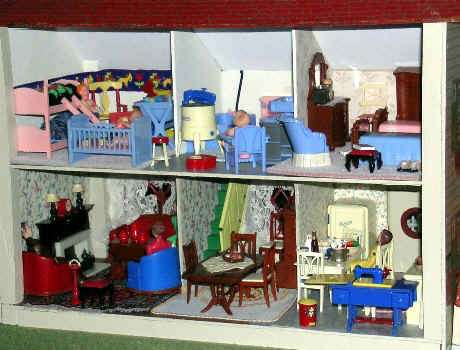 (as in "wood") with yellow and black
as accents. Another disadvantage (or advantage depending upon your point of view) was the
lack of various materials. Plastic represented wood, upholstery, bedding, metal, ceramics,
enamelled steel, etc. There were precedents for this, for example, cast-iron standing in
for wood, textiles and ceramics, as seen in the Arcade line of dollhouse furnishings. In
many plastic pieces, doors opened, crib sides lowered, potty chair trays lifted and
agitators spun in washing machines. The scale could be quite small and this meant a child
could place many pieces in an average dollhouse. For today's collector , there is
particular interest in "dated" items such as phonographs, floor radios, wringer
washers, pedal worked sewing machines and smoking stands. On the other hand, other items
are interesting because they have changed so little such as bathroom fixtures. Decorum was
preserved with twin beds, also seen in contemporary films.
photo: J. McKendryİ
(as in "wood") with yellow and black
as accents. Another disadvantage (or advantage depending upon your point of view) was the
lack of various materials. Plastic represented wood, upholstery, bedding, metal, ceramics,
enamelled steel, etc. There were precedents for this, for example, cast-iron standing in
for wood, textiles and ceramics, as seen in the Arcade line of dollhouse furnishings. In
many plastic pieces, doors opened, crib sides lowered, potty chair trays lifted and
agitators spun in washing machines. The scale could be quite small and this meant a child
could place many pieces in an average dollhouse. For today's collector , there is
particular interest in "dated" items such as phonographs, floor radios, wringer
washers, pedal worked sewing machines and smoking stands. On the other hand, other items
are interesting because they have changed so little such as bathroom fixtures. Decorum was
preserved with twin beds, also seen in contemporary films.
photo: J. McKendryİ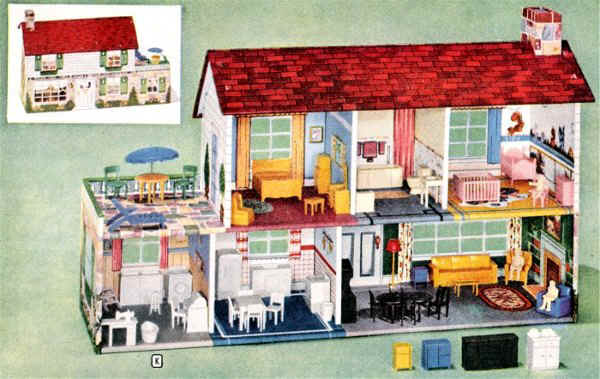
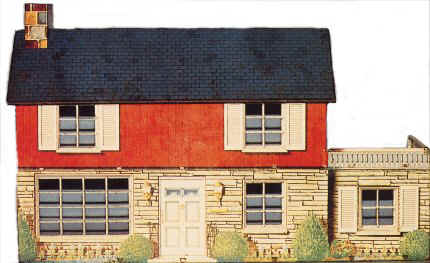

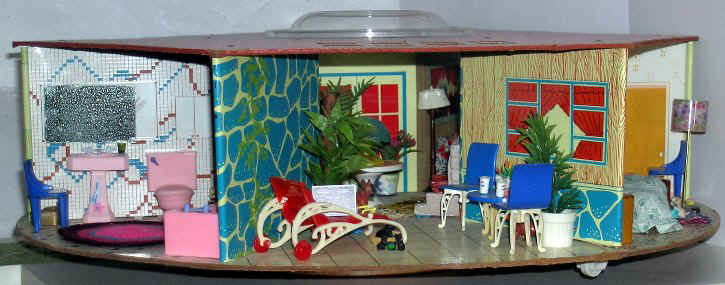
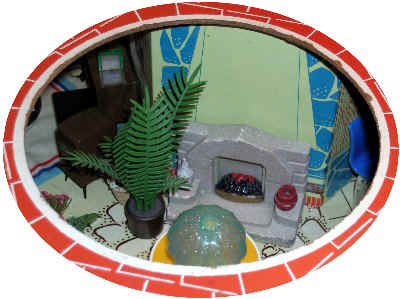 all photo: J. McKendryİ
all photo: J. McKendryİ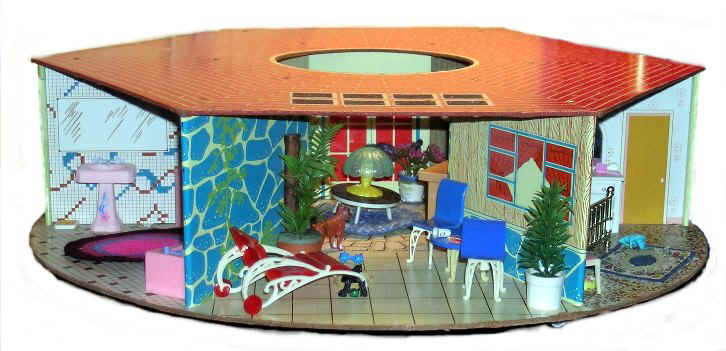
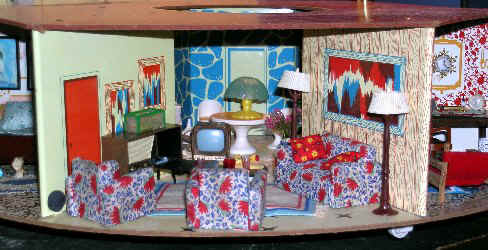
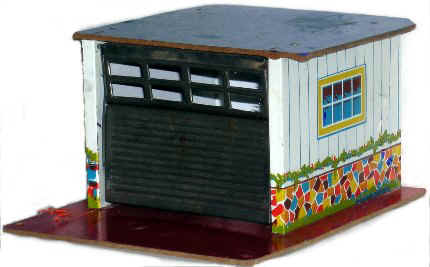
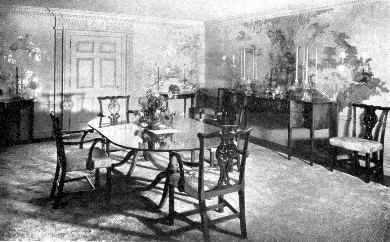
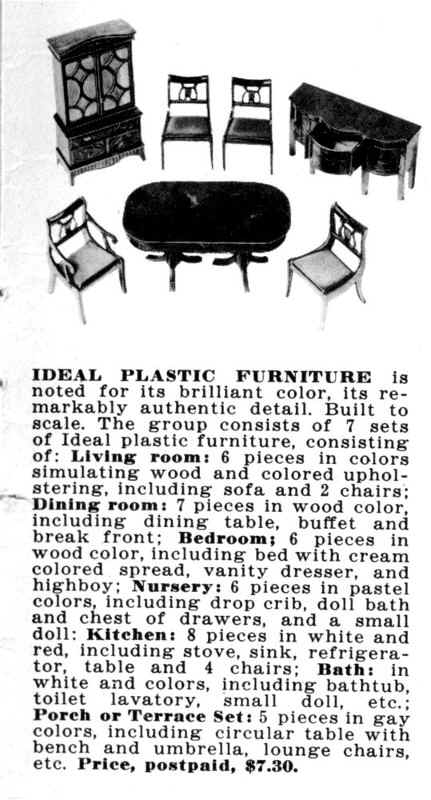
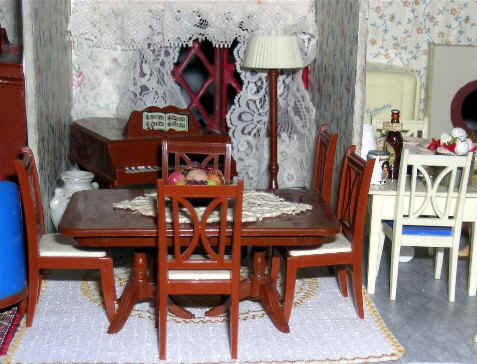
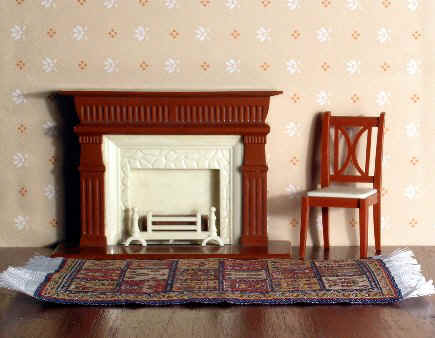
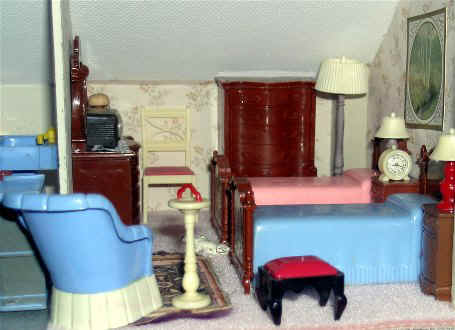
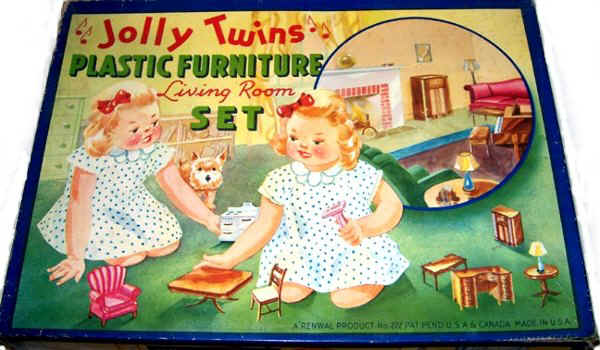
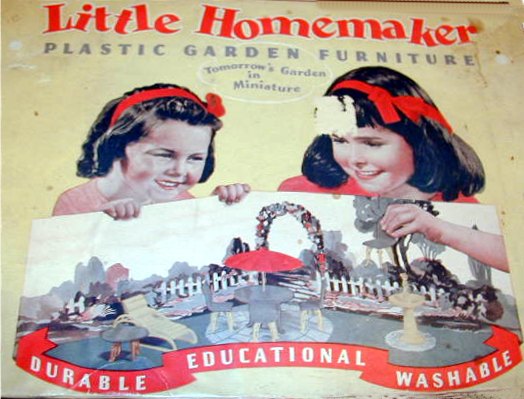

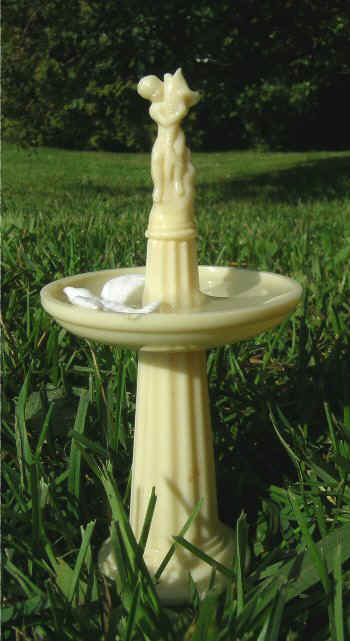
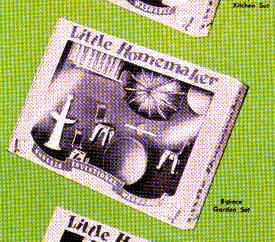
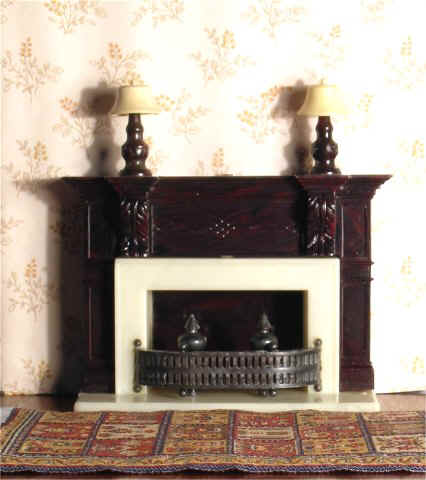
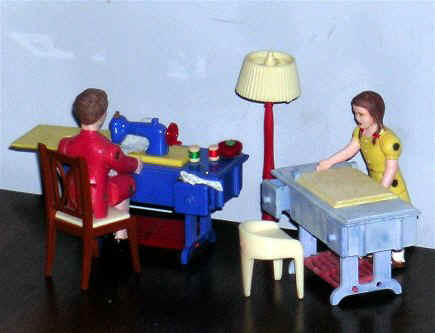
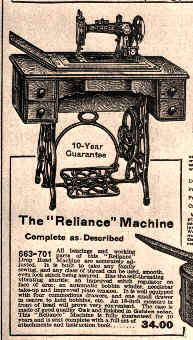
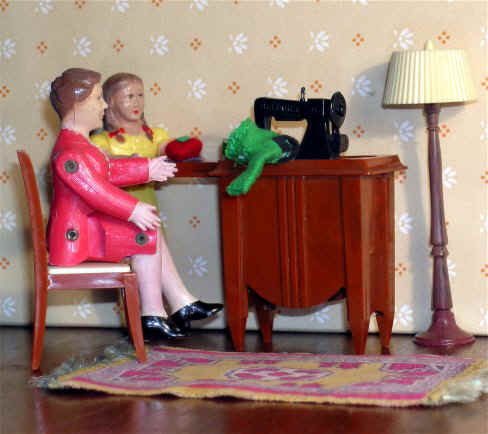 bour by
women in the house to ones that saved time and sweat through electricity. Pumping a sewing
machine with the foot to turn the mechanisms gave way to electrical motors. Ones mounted
on cabinets could be lowered into the casing when not in use; the drawers open and close
in the toy examples above, which are Renwal machines attended to by a Renwal mother and
daughter. The stool is Plasco. The advertisement -- indicating the true situation of a
black painted metal machine and treadle on a wood cabinet (rather than the toy in red,
yellow and blue) -- is from the Canadian retailer Eaton's in their 1926-7 mail-order
catalogue. On the right, mother and daughter enjoy an electric Reliance machine, which
folds into the "wood" cabinet when not in use. The floor lamp is Renwal.
bour by
women in the house to ones that saved time and sweat through electricity. Pumping a sewing
machine with the foot to turn the mechanisms gave way to electrical motors. Ones mounted
on cabinets could be lowered into the casing when not in use; the drawers open and close
in the toy examples above, which are Renwal machines attended to by a Renwal mother and
daughter. The stool is Plasco. The advertisement -- indicating the true situation of a
black painted metal machine and treadle on a wood cabinet (rather than the toy in red,
yellow and blue) -- is from the Canadian retailer Eaton's in their 1926-7 mail-order
catalogue. On the right, mother and daughter enjoy an electric Reliance machine, which
folds into the "wood" cabinet when not in use. The floor lamp is Renwal.